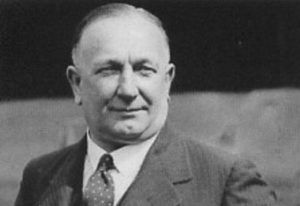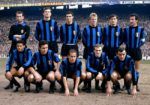In the good old days, the rules of playing football were simple, and so were the tactics. The big and sturdy lads played in the centre of the park and upfront, the hard lads guarded the back, the bright ones played as inside forwards and the little, quick ones played on the wings. The left footed ones played on the left, and the right footed ones played on the right. And the one who had no partner to rely on, played in goal.




Some eight decades ago, 2-3-5 ruled football. Then came this guy called Herbert Chapman who was the manager of Huddersfield Town (and later Arsenal). He decided to change the way the game was played, and switched his team’s formation from the traditional 2-3-5 to the famed W-M formation, which actually translated into 3-2-2-3 on the football pitch. Chapman did away altogether with wing-play, his firm belief that inside passing was “more deadly, if less spectacular than the senseless policy of running along the lines and centering just in front of the goalmouth, where the odds are nine to one on the defenders.”

Herbert Chapman – Man with a plan
Chapman won two FA Cups and five league titles in all with Huddersfield Town and Arsenal between 1922 and 1933 with this ideology, but the image of a winger dribbling, running past full backs and crossing into the box remained the ideal sight to the eyes of English football lovers. One might argue that Chapman’s success should have ended any such notions, but the nostalgia associated with wingers continued to breed in the minds of the English.
Then came the Second World War, and when it ended – there was a sudden influx of wingers in English football. Stanley Matthews, Tom Finney, Jimmy Mullen, Len Shackleton, Charlie Mitten were some of the names that emerged in the aftermath of the war, delighting the spectators with their adventurous displays on the flanks. Suddenly, it seemed that Chapman’s theories had become a thing of the past and wing-play became the trend in English football again.

Stanley Matthews – Greatest conventional winger of all time?
The epitome of wing-play came in 1953, when Stanley Matthews’s heroics on the right wing almost single-handedly won the FA Cup final for Blackpool against Bolton Wanderers. However, the Soviets were scornful of such individualism as against the collectivist mode of theirs, Dinamo Moscow manager Mikhail Yakushin noting that –
“The principle of collective play is the guiding one in Soviet football. A player must not only be good in general; he must be good for the particular team. His individual qualities are high, but we put collective football first and individual football second, so we do not favour his style as we think teamwork would suffer.”
The 6-3 hammering at the hands of Hungary at Wembley – just six months after Matthews’s performance in the Cup final – was just the beginning of the end for the winger in that era. But the final nail on the coffin was the shift from three at the back of a W-M formation to maintaining a back four, thus resulting in a 4-4-2 (or 4-1-3-2) as we know today. The process began during the early 1950s in Hungary, the USSR and Brazil, and gained universal recognition when Brazil won back-to-back World Cups in 1958 and 1962.
Alf Ramsey developed his own ideas on the 4-4-2 formation in the mid 1960s and by the time England won the World Cup in 1966, the winger was no more the traditional winger. He was now regarded as a wide midfielder, who was not only supposed to run down the flank and cross the ball into the box, but also put in a defensive shift by negating the effectiveness of the opposition full backs.
Football tactics continued to evolve, and formations such as the 4-3-3 or the 4-2-4 came into the limelight in the next two decades, when the ‘wide midfielder’ became sort of a ‘wide forward’, but the winger remained a distant memory. The Dutch adopted ‘totaalvoetbal’ or ‘total football’ which brought considerable success, and attacking flair came to be associated with the Netherlands national team and Ajax of that time. However, the popularity of the 4-4-2 persisted, compelling Johan Cruyff to describe its dominance as the “death of football”.

Masters of ‘total football’
The new millennium brought back the wingers, as different formations such as 4-5-1 or 4-2-3-1 came to prominence along with 4-4-2. The 4-2-3-1 accommodated two holding midfielders, which allowed the managers to play wingers with full backs overlapping them. A new breed of wingers – the inverted wingers – cropped up in the meantime who could play on the opposite flank, unlike the one matching their stronger foot. The overlapping full backs remained outside the box while the wingers cut inside.
Such a tendency to move infield was a deviation from the original perception that the true purpose of a winger was to run past defenders to the goal line and whip in a cross into the penalty area. As the lone striker would require some kind of support in the box from midfield when it came to scoring goals, the wingers cut inside to assist the centre forwards. The inverted wingers could come inside onto their stronger foot while attacking the weaker foot of the opposition full back, and it also enabled them to take a better shot on goal. This was the only explanation for the modern directness of such wing-play.
There are numerous examples where an inverted winger operates with an overlapping full back. Robert Pires with Ashley Cole (Arsenal’s ‘Invincibles’), Arjen Robben with Gregory van der Wiel (the Netherlands) or with Philip Lahm (Bayern Munich), Angel Di Maria with Alvaro Arbeloa (Real Madrid) or even Ashley Young or Luis Nani with Patrice Evra (Manchester United) are prime examples.

Arjen Robben – The Inverted Winger
One might also find attacking midfielders drifting onto the opposite flank and doubling up as wingers. The best example that can be cited is Lionel Messi at Barcelona, though there are other prominent ones such as Niko Kranjcar and Luka Modric at Tottenham Hotspur. Cristiano Ronaldo and Wayne Rooney might be known as strikers, but their ability to play anywhere across the forward line means they could occupy a similar role when needed.
Currently, they are few teams in Europe that operate with conventional wingers. Barcelona, the champions of Europe last season, do not have any natural wingers in their team. Players like Iniesta or Dani Alves often play out wide in midfield, but their ‘tiki-taka’ style of play doesn’t require an outright winger as such. Similar is the case with English giants like Chelsea and Arsenal, who usually operate in the 4-3-3 formation.
However, teams like Manchester United, Bayern Munich and Tottenham Hotspur have held on to the belief that wing-play is essential to their counterattacking style. Manchester United have Luis Antonio Valencia, who is a right-footed right winger – a throwback to the good old times. Then there is Gareth Bale, who has been consistently doing well for Tottenham as an outright left-footed left winger.
So the conventional winger has now become a ‘new age’ winger of sorts – one who can take on full backs, score goals and operate as a playmaker rather than just getting to the by-line and curl in crosses. With the evolution of tactics, one might as well witness him doing just about everything there’s to do with the ball on the pitch.
This Post first appeared on Sportskeeda
–Abhinav Chakraborty









Recent Comments